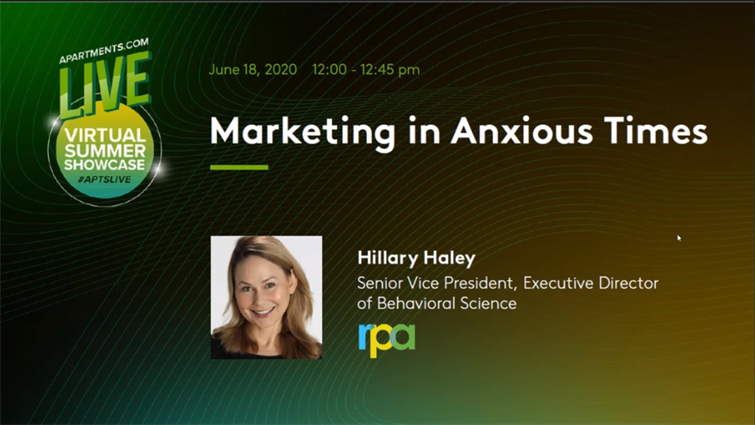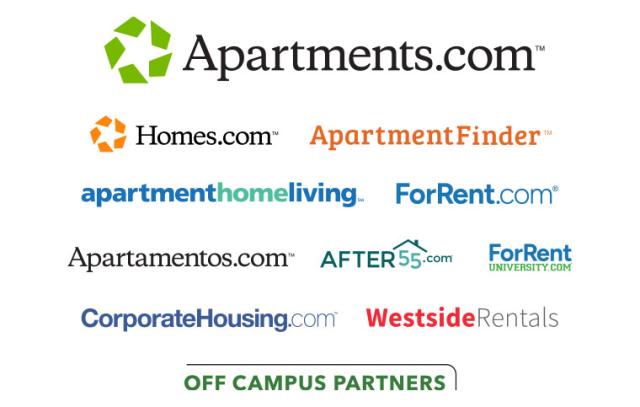
Apartments.com held its first Virtual Summer Showcase June 18-19, featuring digital media and marketing presentations from a rockstar lineup of industry experts.
We’re not dealing with the same customer. One-third of people were showing signs of clinical anxiety or depression by the end of April. Many are in panic mode.
“It’s important for marketers to help to keep them grounded,” Hilary Haley, Senior Vice President of Behavioral Science, RPA, said. “Marketers’ role is to be sensitive because their customers’ heads are racing due to receiving so much stimulus. Everyone is in a different stage of coping: Denial, panic, knowledge immersion, social calibration, depth insight, internalized change.
“You must support, support, support. Speak in positive terms. There are no right or wrong answers, you just have to support them.”
Haley shared thoughts and strategies for the near and longer term when communicating with customers June 18 during Apartments.com’s Virtual Summer Showcase.
Short-term. Stay in the conversation. Be human. Everyone has tunnel vision. What might only be a day, to them, it will feel like a week. A week will feel like a month.
“Different people will respond in different ways, and respond differently over time,” Haley said. “Communicate in a way that “works” for multiple emotional styles and multiple situations—and makes no presumptions at all about how people might be feeling at any time.
Medium-term. Embed yourself in their daily habits so that you can protect your brand. Understand that some people will be reconsidering their loyalties. Given these situations outside the norm, they might be trying new products or a different way of doing things, so they are open to change.
“Look for new segments that may be coming into market, and consider how emerging habits may naturally translate into emerging marketing opportunities,” Haley said.
“In the past, what might have been a treat – such as buying a Frappuccino – is now a chore (you have to get out and drive to pick one up). What used to be considered boring – like staying home – is not considered safe, and something you want to do.”
Ninety percent of renters say they’ve made big lifestyle changes since March.
“Because of social distancing, apartment marketers’ messaging should highlight ‘secluded location’ and ‘private entrances.’ Showcase your outdoor spaces and show gardens, windows and sunlight more prominently. Make it easy for people to find properties with ‘home offices’ or ‘private nooks.’”
Three-fourths of people now consider their home as a sanctuary. “Because they are spending more time at home, provide space-maximization tips and highlight terms such as ‘multi-purpose,’ Haley said.
“Boast about cooking from home by pointing to gourmet kitchens. More than 40 percent of Millennials are seeking ‘un-urban’ digs and are more interested in suburban/country life. Highlight features and attributes such as nature setting and quiet neighborhood.”
Long-term. Respond authentically to customers to solidify a meaningful social interaction. Authenticity validates the response and it can be used to protect one another.
“Understand that today everyone wants to help,” said Haley, noting that the phrase “help other people” is up 147 percent since March.
The app NextDoor is seen booming popularity. It’s doing a good job of bringing people together who live in the same neighborhood.
People are expressing that they are feeling closer to their family and friends and desire a feeling to come together with them.
“Make things shareable, and ideally giftable, whether it’s browsing, shopping, reviewing, reading FAQs, finding tips, or anything else, people want to share experiences with others,” Haley said.
“Remain extra-sensitive to key identity groups. For example, identities such as ‘essential worker’ and ‘elderly’ are very salient right now. Keep this in mind when evaluating communication. Take stock of influencers, celebrities, and brand mascots.
“And when it comes to humor, always think it through. Consider that social networks are in transition. People may rely more heavily on friends and family right now than they usually do. What does this mean for marketing? Opportunities like referrals, shared resources and scheduled co-shopping.”
Nearly three-quarters (72 percent) of people are seeking ways to help local businesses. There’s a huge spike in the number of ‘rescue dog’ adoptions.
Make it easy to help—but not “too easy,” Haley said. “You want people to feel good about helping, so make it foolproof,” she said. “At the same time, require some effort. When people invest time and energy, they feel more connected.”
Longer-term.
Within the edges, there are three highly intertwined macro-clusters of values that we see rising up in coming months, supported by early survey data and behavioral patterns. Here are national ad messages that have scored well in public perception:
FAMILY FIRST: “If you can call the people around friends or family, you’ve already won.” – Guinness
INDEPENDENT SPIRIT
“No matter how far down we may be, we are never too far down to come back” – Nike
COMMUNITY CARE:
”We all need our small businesses. And right now, they need us.” -- Verizon
Create response and action strategy based on periods of three, four or five months. “Don’t get into too many specifics of what you are doing. Take it slowly. With apartments, messaging should be geared toward the “lifestyle” and “experience” that your community offers, and not specific this or that.”
Recap compiled by freelance reporter Paul Bergeron.








